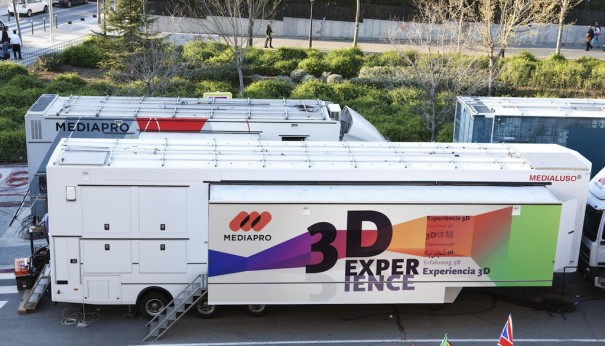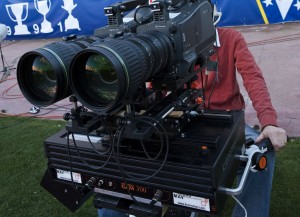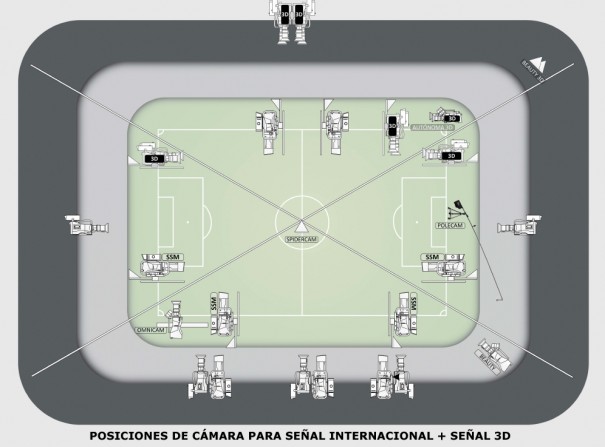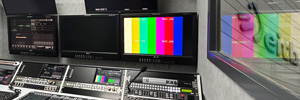All the excitement of Madrid-Barça, in 3D, with Mediapro
For the first time, a dozen countries broadcast the match in 3D. Thirty cameras and more than three hundred professionals ensured the best signal relay for everyone. EVS deployed an important operation so as not to miss a detail of this meeting.
On Saturday, April 16, the whole planet was watching one of the most anticipated matches of the year: the one between Real Madrid and FC Barcelona.
The international signal produced by Mediapro was distributed to all countries in the world in HD and, for the first time, in 3D to a total of seven European channels. Thanks to the agreements signed by Mediapro, all the excitement and spectacularity offered by this format could be followed on Canal+ France, JCF Israel, Sky Italy, Canal+ Poland, Sky England, Canal+ Sweden and BETV Belgium, which premieres its first 3D channel for the occasion. The meeting could also be seen in 3D in cinemas in Hungary, the Czech Republic and Slovakia with the agreement signed with Chello, which has a network of 3D cinemas in these countries.
Mediapro threw itself fully into producing in 3D one of the matches that raises the greatest global expectation. The specific device for the realization of the 3D signal employed 40 professionals and a total of seven double camera positions installed on five robotic rigs (two mirror and three in side-by-side configuration), plus a fixed rig and an autonomous camera, all of them from its technological partner Kronomav.
The entirety of the encounter occurred in 3D without using any kind of automatic conversion from 2D to 3D. A mobile unit prepared for the realization of the 3D signal was moved to the Santiago Bernabéu and the 3D graphics were also inserted in real time.
More than 300 professionals, 30 cameras in the stadium, of which 13 exclusively for LaSexta and seven for the broadcast of the match in 3D, as well as seven mobile units guaranteed the best broadcast of Real Madrid vs. FC Barcelona.
In total there were a dozen cameras placed at the foot of the field. Of these, two will be Super Slow Motion, an Omnicam and for the first time in the Spanish League, a Spidercam. This type of camera allows you to obtain shots with overhead movements and game tracking. Other cameras, belonging to Telemadrid, TV3, BSkyB, ESPN, Canal+ France, Direct TV and Al Jazeera allowed the personalization of the signal for these channels.
Mediapro distributed the international signal to all countries in the world and will carry out the production of the match under the supervision of Dani Lozano.
England, France, Italy, Germany, the countries of the Persian Gulf, the United States, South America, Mexico, Singapore, Hong Kong, China, Australia, Japan, and much of North Africa and Sub-Saharan Africa, among others, followed live one of the sporting events that has generated the most expectation in recent times. The international audience exceeded a potential of 400 million viewers worldwide, with actual audience peaks of 100 million.
Madrid-Barça also in cinema
Real Madrid vs. FC Barcelona could also be followed in the best movie theaters in HD and Dolby Surround sound. 12 rooms throughout Spain will be set up to follow a sporting event.
The HD broadcast means enjoying all the excitement of football on the big screen with great image quality. In addition, the Dolby Surround sound without voice-over allows you to fully immerse yourself in the game, getting to appreciate sounds, such as the ball being hit by the players or the screams of the fans, impossible to perceive from the stands.
EVS Speeds Up Editing
Both for the international signal and for the preparation of the post-match highlights, the technology of EVS played a prominent role. From Mediapro's main mobile unit, a total of eight XT2+ servers recorded the signal from 23 cameras, including Super Slow Motion.
The creation of the offside line overlay graphic was managed using the EVS Epsio system. This solution allows LSM operators (using standard EVS LSM remote controllers) to instantly generate an overlay graphic with automatic recognition of pitch boundaries. Thanks to a calibration assistant, whereby each camera sends images of the pitch at predefined angles to the system, Epsio is able to instantly and automatically recognise the pitch during actions, and virtually draw offside lines within the boundaries of the pitch. This one-second operation can be selected with a single button. The special preview of the graphic overlay will ensure the availability of the offside lines when the director decides to repeat the action.
With EVS's IPDirector, segments of between 8-10 minutes were pre-edited and stored in the XFly, the Belgian company's new transportable removable storage. XFly is a compact and portable storage platform aimed at expanding live production operations. The system includes eight standard SAS or SATA disk drives (2.5 inches) that offer a storage capacity of up to 8 TB with a maximum capacity of up to 140 hours of HD material at 100 Mbps.
XFly is designed with advanced security features, including RAID 5 technology for maximum reliability in any live production situation. This new portable system is designed to provide EVS XT/XS server operators with an easy backup alternative for clips and sources. When the shoot is complete, the operator can simply transport the entire production, including all sources, multi-camera angles and highlights in a simple enclosure of approximately 13x20x33 cm (H-W-L). Once the XFly returned to Barcelona with the multi-cameras, including the Super Slow Motion, the material was simply loaded into an IPEdit outlining the multi-camera editing before moving on to Avid and ProTools to include effects.
Did you like this article?
Subscribe to our NEWSLETTER and you won't miss a thing.

















